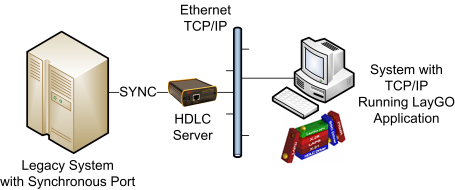
While the LayGO PXS is designed for autonomous operation, it can also function as a LayGO synchronous communication controller. Running the LayGO HDLC Server program, hdlcsrv, the PXS can be used as if it were an expansion card plugged directly into the PCI bus of a PC. The synchronous communication capability of the PXS is then available to clients through a special PXS-enabled version of the LayGO API. In this scenario, all of the services of the LayGO protocol stack are available on the host, since the stack is actually running on the host. Only at the Hardware Interface does the PXS-enabled LayGO stack transparently convert function calls to a driver in the OS kernel into TCP/IP messages to a HDLC driver server running on the PXS.

The advantage of this scheme is that programs written using the LayGO API can run, unmodified, using the PXS. The only difference from a LayGO client application's point of view is in the LayGO .cfg file (which is modified to contain the IP addresses of up to 8 PXSs, as explained in Configuring LayGO for the PXS) and in the shared libraries the application uses. There is no difference at all at the source code level.